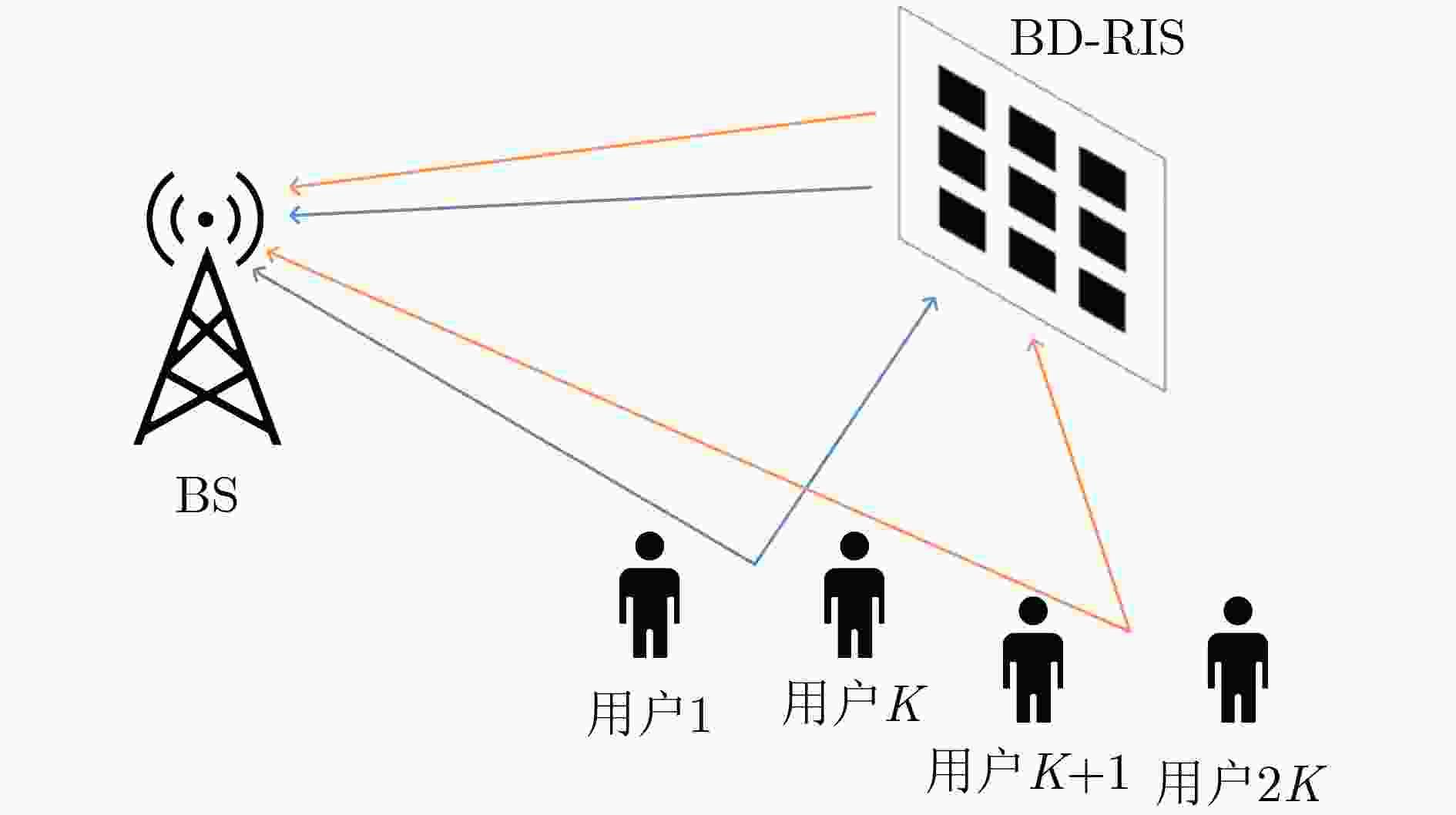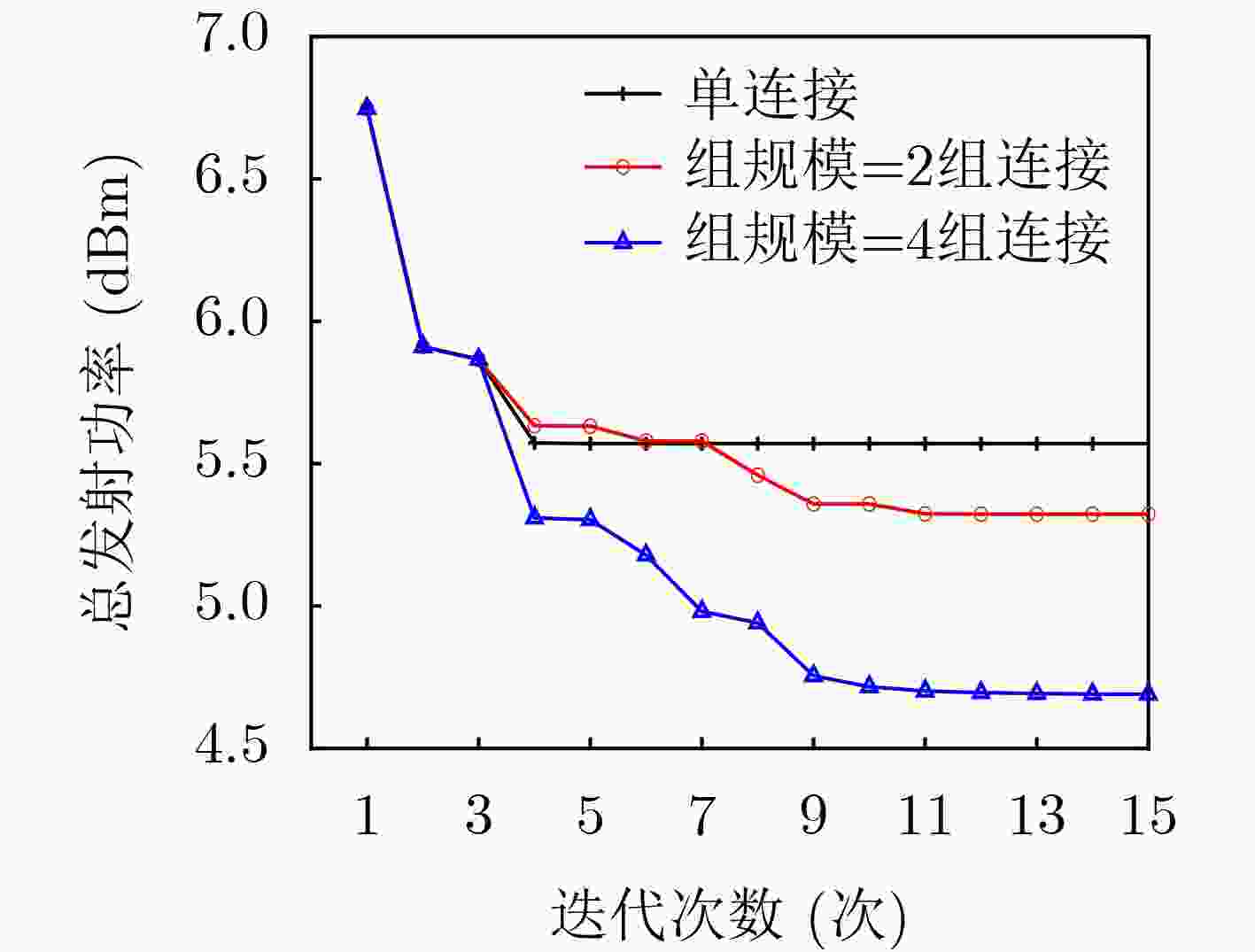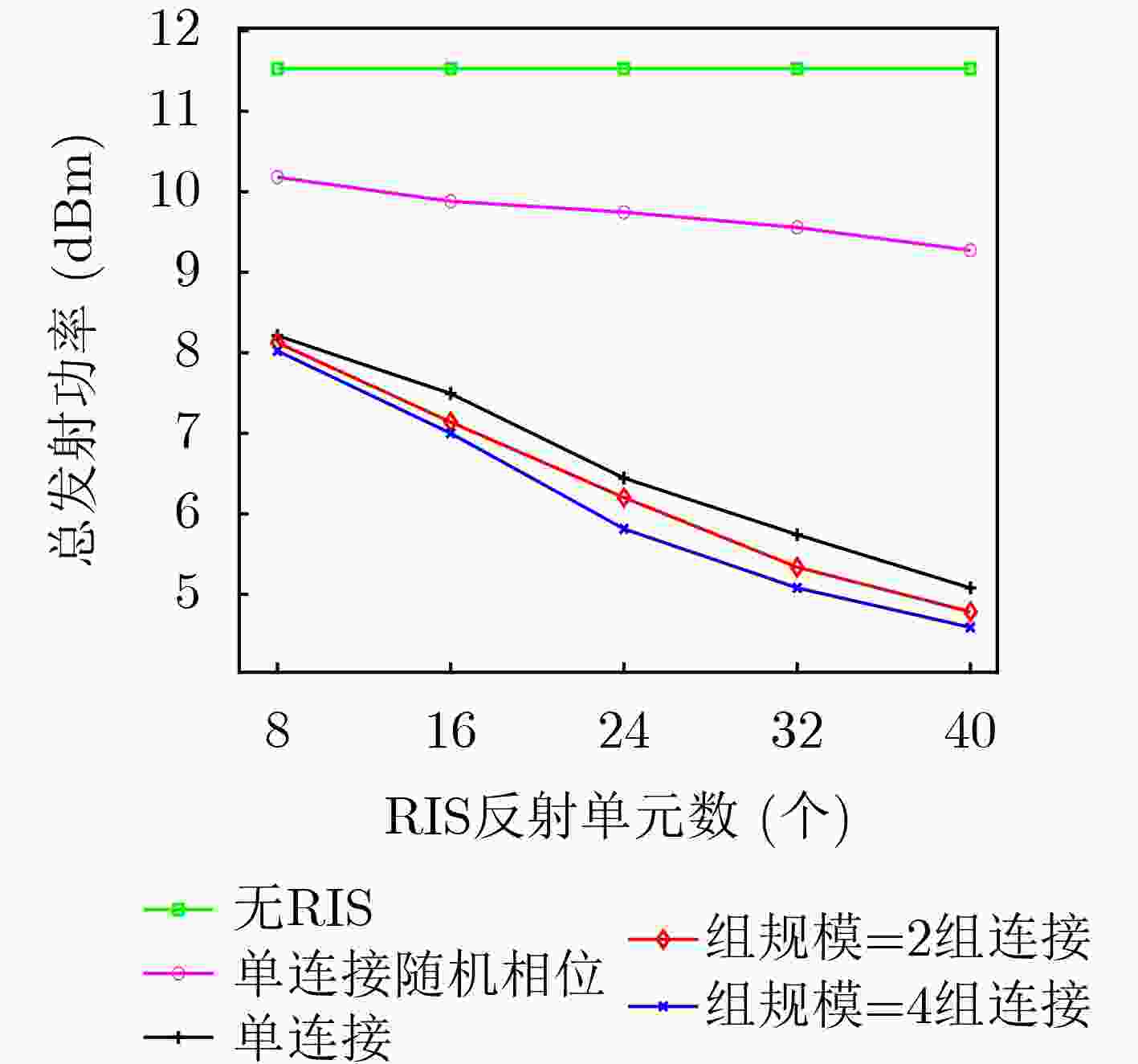Research on Low-Power Transmission Method for Group-Connected Beyond-Diagonal Reconfigurable Intelligent Surface-assisted Communication Systems
-
摘要: 可重构智能表面(RIS)被视为未来无线通信中前景广泛的关键技术之一。超对角可重构智能表面(BD-RIS)作为RIS的一种新型架构,相移矩阵不限于对角矩阵的结构,为通信系统设计带来了更高的自由度。该文针对组连接BD-RIS辅助的上行通信系统展开研究,通过联合优化均衡器、用户发射功率和BD-RIS的相移矩阵来降低通信系统的总发射功耗。具体来说,采用最小均方差(MMSE)均衡器使得各个用户接收信干噪比(SINR)最大,接着推导了用户发射功率与相移矩阵之间的表达式,并进一步将相移优化问题转化为无约束的单变量优化问题,最后交替优化均衡器、用户发射功率和BD-RIS相移矩阵使得系统发射功率最小。仿真结果表明,与多种基准方案相比,该文提出的组连接BD-RIS辅助的上行通信系统传输方案能有效降低系统功耗。
-
关键词:
- 超对角可重构智能表面 /
- 功率最小化 /
- 上行通信 /
- 交替优化
Abstract:Objective Reconfigurable Intelligent Surface (RIS) technology enables dynamic reconfiguration of the wireless communication environment. Among recent advancements, Beyond-Diagonal RIS (BD-RIS) has emerged as a novel architecture, featuring a phase-shift matrix unconstrained by diagonal form. This allows simultaneous adjustment of phase and amplitude, offering greater design flexibility and improved system performance. However, while prior studies have primarily focused on BD-RIS-assisted downlink systems, the uplink counterpart remains unexplored. Unlike downlink transmission, where only the total base station power is constrained, uplink transmission imposes individual power limitations on each user, necessitating different optimization models. Therefore, existing downlink-oriented design approaches cannot be directly applied to uplink scenarios. This study proposes a low-power transmission method tailored for BD-RIS-assisted uplink systems, addressing the unique constraints and challenges of uplink-communication. Methods This study investigates a group-connected BD-RIS-assisted uplink communication system to minimize total transmit power by jointly optimizing the equalizer, user transmit power, and BD-RIS phase-shift matrix. The Minimum Mean-Square Error (MMSE) equalizer is employed to maximize the Signal-to-Interference-plus-Noise Ratio (SINR) of each received signal. Subsequently, an analytical expression linking user transmit power and the phase-shift matrix is derived. The phase-shift optimization problem is then reformulated as an unconstrained univariate optimization problem. Finally, an alternating optimization approach is applied to iteratively refine the equalizer, user transmit power, and BD-RIS phase-shift matrix, achieving minimal system transmit power. Results and Discussions The proposed scheme is compared with benchmark methods, and simulation results demonstrate its superior convergence ( Fig. 2 ) and performance (Figs. 3 and4 ). The group-connected BD-RIS achieves lower total transmit power than the traditional single-connected RIS (Figs. 3 and4 ) due to its ability to manipulate both the phase and amplitude of signals, leading to enhanced system performance. Furthermore, larger group sizes in the group-connected BD-RIS result in improved performance (Figs. 3 and4 ), as increased group size provides greater design flexibility, further optimizing system efficiency.Conclusions To address the limitations of existing BD-RIS research, this study investigates a group-connected BD-RIS-assisted uplink communication system and proposes a method to minimize total transmit power. An optimization problem is formulated to minimize user transmit power, and an alternating optimization approach is employed to iteratively refine the equalizer, user transmit power, and BD-RIS phase-shift matrix. Specifically, the MMSE equalizer maximizes each user’s SINR, a closed-form expression for user power is derived, and the phase-shift optimization problem is transformed into an unconstrained single-variable optimization problem, achieving minimal system power consumption. Simulation results indicate that, compared with the traditional single-connected RIS, the group-connected BD-RIS achieves lower system transmit power, with performance improving as group size increases. This study assumes perfect channel state information; however, in practical RIS-assisted communication systems, accurately obtaining ideal channel state information is challenging. Future research should consider the effects of non-ideal channel state information. -
表 1 仿真参数
参数 数值 基站到RIS的距离(m) 200 用户到RIS的距离(m) 10~50 噪声功率${\sigma ^2}$(dBm) –70 LoS的相关因子 1 莱斯因子 4 路径损耗指数[$ {\alpha_{{\mathrm{B}},k}},{\alpha_{{\mathrm{B,I}}}},{\alpha_{{\mathrm{I}},k}} $] [3, 2.6, 2.4] BD-RIS参考阻抗${Z_0}$($\Omega $) 50 -
[1] 马红兵, 张平, 杨帆, 等. 智能超表面技术展望与思考[J]. 中兴通讯技术, 2022, 28(3): 70–77. doi: 10.12142/ZTETJ.202203012.MA Hongbing, ZHANG Ping, YANG Fan, et al. Reflections on reconfigurable intelligent surface technology[J]. ZTE Technology Journal, 2022, 28(3): 70–77. doi: 10.12142/ZTETJ.202203012. [2] 姚建文, 王楠. 智能反射面——大有前景的6G技术[J]. 电信快报, 2020(7): 8–13. doi: 10.3969/j.issn.1006-1339.2020.07.002.YAO Jianwen and WANG Nan. Intelligent reflecting surface: A promising technique for 6G[J]. Telecommunications Information, 2020(7): 8–13. doi: 10.3969/j.issn.1006-1339.2020.07.002. [3] PAN Cunhua, REN Hong, WANG Kezhi, et al. Reconfigurable intelligent surfaces for 6G systems: Principles, applications, and research directions[J]. IEEE Communications Magazine, 2021, 59(6): 14–20. doi: 10.1109/MCOM.001.2001076. [4] LIU Yuanwei, LIU Xiao, MU Xidong, et al. Reconfigurable intelligent surfaces: Principles and opportunities[J]. IEEE Communications Surveys & Tutorials, 2021, 23(3): 1546–1577. doi: 10.1109/COMST.2021.3077737. [5] WU Qingqing and ZHANG Rui. Towards smart and reconfigurable environment: Intelligent reflecting surface aided wireless network[J]. IEEE Communications Magazine, 2020, 58(1): 106–112. doi: 10.1109/MCOM.001.1900107. [6] LI Hongyu, SHEN Shanpu, and CLERCKX B. Beyond diagonal reconfigurable intelligent surfaces: From transmitting and reflecting modes to single-, group-, and fully-connected architectures[J]. IEEE Transactions on Wireless Communications, 2023, 22(4): 2311–2324. doi: 10.1109/TWC.2022.3210706. [7] NERINI M, SHEN Shanpu, LI Hongyu, et al. Beyond diagonal reconfigurable intelligent surfaces utilizing graph theory: Modeling, architecture design, and optimization[J]. IEEE Transactions on Wireless Communications, 2024, 23(8): 9972–9985. doi: 10.1109/TWC.2024.3367631. [8] NERINI M, SHEN Shanpu, and CLERCKX B. Closed-form global optimization of beyond diagonal reconfigurable intelligent surfaces[J]. IEEE Transactions on Wireless Communications, 2024, 23(2): 1037–1051. doi: 10.1109/TWC.2023.3285262. [9] LI Hongyu, SHEN Shanpu, NERINI M, et al. Beyond diagonal reconfigurable intelligent surfaces with mutual coupling: Modeling and optimization[J]. IEEE Communications Letters, 2024, 28(4): 937–941. doi: 10.1109/LCOMM.2024.3361648. [10] SHEN Shanpu, CLERCKX B, and MURCH R. Modeling and architecture design of reconfigurable intelligent surfaces using scattering parameter network analysis[J]. IEEE Transactions on Wireless Communications, 2022, 21(2): 1229–1243. doi: 10.1109/TWC.2021.3103256. [11] SANTAMARIA I, SOLEYMANI M, JORSWIECK E, et al. SNR maximization in beyond diagonal RIS-assisted single and multiple antenna links[J]. IEEE Signal Processing Letters, 2023, 30: 923–926. doi: 10.1109/LSP.2023.3296902. [12] FANG Tianyu, MAO Yijie, SHEN Shanpu, et al. Fully connected reconfigurable intelligent surface aided rate-splitting multiple access for multi-user multi-antenna transmission[C]. 2022 IEEE International Conference on Communications Workshops (ICC Workshops), Seoul, Korea, 2022: 675–680. doi: 10.1109/ICCWorkshops53468.2022.9814551. [13] GUANG Zhaohui, LIU Yang, WU Qingqing, et al. Power minimization for ISAC system using beyond diagonal reconfigurable intelligent surface[J]. IEEE Transactions on Vehicular Technology, 2024, 73(9): 13950–13955. doi: 10.1109/TVT.2024.3385633. [14] LIU Liu, WANG Hong, and SONG Rongfang. Optimization for multi-cell NOMA systems assisted by multi-RIS with inter-RIS reflection[J]. IEEE Communications Letters, 2024, 28(1): 123–127. doi: 10.1109/LCOMM.2023.3314627. [15] YANG Xiaolong, WANG Hong, and FENG Youhong. Sum rate maximization for active RIS-aided uplink multi-antenna NOMA systems[J]. IEEE Wireless Communications Letters, 2023, 12(7): 1149–1153. doi: 10.1109/LWC.2023.3264516. [16] CHU Hongyun, PAN Xue, JIANG Jing, et al. Adaptive and robust channel estimation for IRS-aided millimeter-wave communications[J]. IEEE Transactions on Vehicular Technology, 2024, 73(7): 9411–9423. doi: 10.1109/TVT.2024.3385776. [17] CHU Hongyun, YANG Mengyao, PAN Xue, et al. Joint active and passive beamforming design for hybrid RIS-aided integrated sensing and communication[J]. China Communications, 2024, 21(10): 1–12. doi: 10.23919/JCC.ja.2023-0213. -






 下载:
下载:





 下载:
下载:
